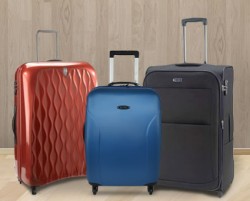 Modern travelling needs have changed quite dramatically – and quite quickly. Since the September 11 attacks on the World Trade Center, the security requirements of airlines (which are still one of the most popular forms of long haul travel) have altered the way we think about our flight baggage.
Modern travelling needs have changed quite dramatically – and quite quickly. Since the September 11 attacks on the World Trade Center, the security requirements of airlines (which are still one of the most popular forms of long haul travel) have altered the way we think about our flight baggage.
The prudent airline traveller has, wherever possible, always avoided hold baggage. Waiting in line to retrieve a suitcase after a long flight can add an hour or more to the time it takes you to leave an airport. When you factor in the increased security, you’re looking at a significant chunk of time just to get in and out of the airport.
Modern “smart luggage” provides some answers – provided that the length of time for which a person travels does not dictate that he or she takes a suitcase too large for carry on.
Wheeled suitcases, fitted with pull handles and designed to be the right size for fitting in the overhead baggage lockers, have become prevalent among business travellers. It is now possible to get onto your flight without having to check baggage in – and to leave at the other end without having to wait interminably by the carousel.
By not having to check baggage in, business travellers in particular are avoiding queues as they are then able to check in using automatic check in stations.
Smart luggage can be smart on the inside as well. If you are going to fit a case into the size restrictions of an overhead locker, then you give yourself certain requirements that you may not otherwise have had. It’s always important to compartmentalise luggage – when the overall size of the case is small, the ingenuity of the interior design becomes much more important.
It is, for instance, imperative that business clothes are kept smart. Indeed, keeping ironed clothes well pressed without allowing them to crease has always been a primary concern of a luggage designer In a smaller space, compartments must be arranged so that common items of clothing may be separated from each other in a proper fashion – shirts from trousers or skirts, for example; and socks and underwear from ties and cuff links.
Smart luggage needs to be well designed ergonomically too. The smaller the case, the closer its top part (the handled part) is to the ground. So the user, if he or she is not to stoop when wheeling the case along in airport terminals, must have access to a long telescoping handle.
The length of the telescoping handle may be fixed – or in more designed models, the user may be able to click-stop the handle at various intervals, ensuring that he or she is able to pull it along at a level comfortable for his or her own height.
The wheels on the corners of smart luggage have two functions to perform. On the one hand, they must be prominent enough to offer a proper rolling surface for the case to travel on. On the other, they must be inset to a level where they are not problematic when the case is not being used in its wheeled mode.
The more thought that goes into the design of smart luggage and luggage sets, the more multi-functional the end results become. From cabin baggage to hold suitcases, there’s always a place for better technology.
Adriana Frederick is a former air hostess. She now writes a number of travel blogs, and has recently been invited to help design smart luggage for business travellers.















